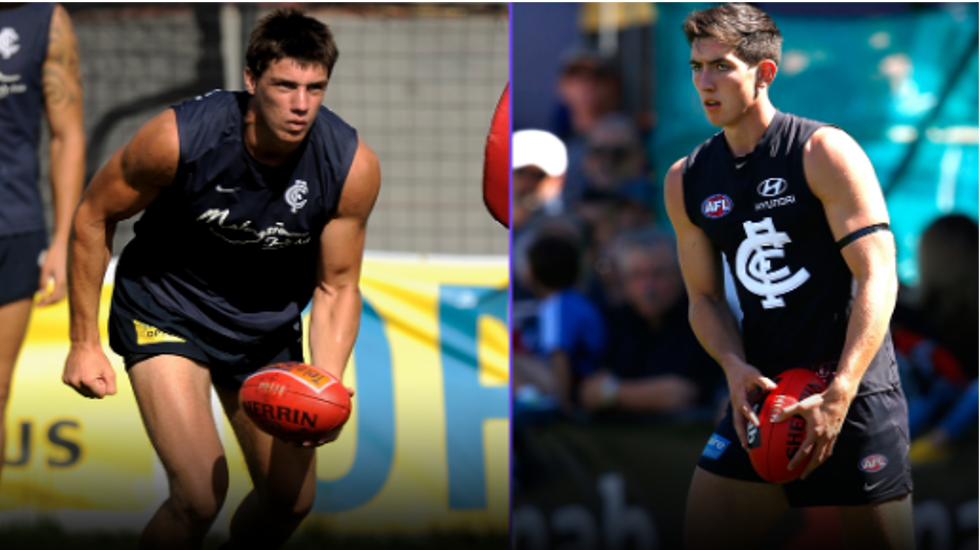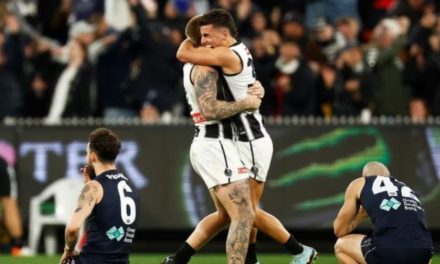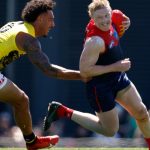Matthew Kreuzer, No.1 pick in 2007 (left) and Jacob Weitering, No.1 in 2015. Carlton fans learned to be a lot more patient in the intervening eight years.
Timing can be everything in football, and coming up to the 10th anniversary of his induction into the AFL system, Jack Watts might well still be cursing his.
The 2018 AFL draft is on in a bit over a week, and while the leading contenders have been the subject of some speculation and profiling, it’s fair to say expectations these days are a little more realistic than when Watts was one of those candidates.
Whichever talented kid ends up as the first player picked, they’re very unlikely to endure the sort of crushing burden the boy from Brighton Grammar had to carry from the moment Melbourne called out his name at the draft table in November 2008.
Really, it was the perfect storm. Good-looking private school boy gets the No.1 branding, goes to a club with a close historical connection to the elite educational institutions, and at a time when it was desperately looking for some good news.
Watts’ every move was scrutinised in forensic detail, his senior debut foreshadowed long before it actually came, and when the moment finally arrived, perhaps the closest thing football has seen to the Christians being thrown to the lions.
It was the big-ticket Queen’s Birthday game between Melbourne and Collingwood, 61,000 people present, the Demons bottom of the ladder with just one win rolling out their 18-year-old “star” in the hope of some inspiration.
The very first time Watts went near the ball he was set upon by three Magpies eager to “welcome” him to the big time. And in a way, that image has lingered over his career ever since, even after 172 games and now a second club in Port Adelaide.
Watts hasn’t helped himself at times with a casual attitude, lack of consistency always the bugbear. But after 10 seasons in the AFL system, you still can’t help but think what might have been had he been pick No.21 and not the first selection, able to build some confidence freed from the demand that he immediately turn in the sorts of performances the football world assumed a No.1 next to his name would guarantee.
Why are we more forgiving these days? Perhaps the Watts story has helped shape a more realistic view of what could be expected of junior recruits. But there’s a number of other factors as well.
There’s no doubt that the advent of free agency has completely changed the recruiting dynamic. Big names now regularly change clubs. Free agency accounts for some, but others are more likely to be the subjects of trade deals before they qualify, as clubs try to get in first and secure players or more favourable draft picks than they might end up with via the compensation pick that comes with the loss of a free agent.
Those already established players attract by far the biggest amount of hype now, as they should, this year the likes of Dylan Shiel, Tom Lynch, Dayne Beams, Lachie Neale, Dan Hannebery, Chad Wingard, Jesse Hogan all changing clubs.
Contrast that with the lead-up to Watts’ 2008 draft. In that year’s trade period, just six deals were done. Rhyce Shaw’s switch from Collingwood to Sydney was by far the biggest. The other five players traded were Farren Ray, Brent Prismall, Robert Warnock, Anthony Corrie and Adam Thomson. Hardly “hold the back page” material.
But with no shortage of household names now on the move each trade period, the hype surrounding the leading draft contenders these days is minimal in contrast.
You’ll hear plenty about names like Sam Walsh, Jack Lukosius, Max King, Bailey Smith and Izak Rankine in 10 days or so, but nobody is going to expect them to have a major influence on their club’s performance in 2019. If they do, it will be a bonus.
That attitude gives permission for debutants in most cases still teenagers to take the odd backward step, to have the odd spell in the VFL when their form tapers or when bodies still not hardened to the rigours of AFL football begin to feel the strain.
Perhaps the clubs themselves have always got it. But in this age, the football media and public increasingly get it, too.
There’s an interesting example of the shifting mentality at Carlton, particularly. Matthew Kreuzer was drafted at No.1 in 2007, his reputation so lofty that when the Blues and fellow-strugglers Melbourne played each other in the final game of the season, a priority draft pick on the line, the game was jokingly referred to as the “Kreuzer Cup”.
Injuries, but also lofty expectations have made Kreuzer’s AFL path often difficult. He certainly wasn’t cut the same slack as another Carlton No.1 pick in Jacob Weitering, the first player selected in 2015.
Perhaps Blues fans have become used to having to be patient, but Weitering’s odd stumbles in his first three seasons have been seen far more sympathetically, part and parcel of a young player’s development, regardless of the draft number appearing next to his name.
All of which is little comfort to the now 27-year-old Watts. The Port Adelaide player still has time to make a sizeable impact on AFL football. But it’s hard to let go of the idea that had the sensibilities surrounding the AFL draft in 2018 been the case in 2008, he may already have done so.
*This article first appeared at SPORTING NEWS.











